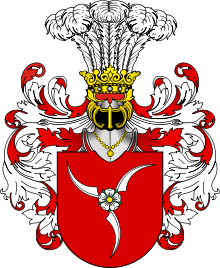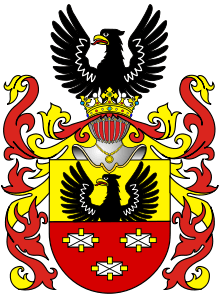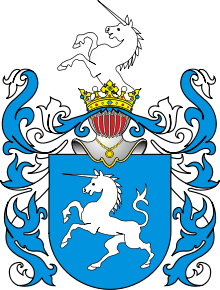Danielewicz family
Danielewicz vel Danilewicz - descendants of Daniel or Danilo. Until the end of the 18th century, mainly used by highly ranked nobility of Polish–Lithuanian Commonwealth.
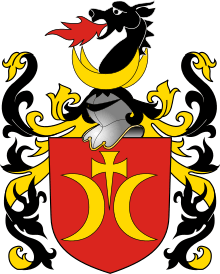
Danielewicz vel Danilewicz of the Clan of Ostoja
Danielewicz vel Danilewicz was an ancient noble family name in Lithuania, Russia and in the Polish–Lithuanian Commonwealth.[1][2] On the political scene Danielewicz supported the Clan of Ostoja expansion in the 15th century and in Lithuania was closely related to the Pac family.[3] In medieval times, nobles in Lithuania with the power of judging like Danielewicz were called barones according to Jan Długosz.
During many centuries, Ostoja Danielewicz family was holding high offices as Lords of Regality (Starosta) and Judge.[1]
Ostoja Danielewicz vel Danilewicz during the time of Commonwealth
_Google_Cultural_Institute.jpg)
The Danielewicz of Ostoja family are to be found mainly among officials in the districts of Vilnius, Ashmyany, Trakai and Vilkmergė. Sources tell about Daniel that had had two sons and one daughter and of them Dawid Danielewicz was the Judge of Vilnius in the middle of the 15th century. In 1530 Michał Danielewicz was in possession of 10 villages with different economic buildings on the property. His grandson, Jan Karzimierz Danielewicz was deputy to the Sejm from the Vilnius district. Iwaszko Iwanowicz Danielewicz attended at the Royal Court in Kraków year 1511, his brother Fedor attended same court year 1523.[4][5]
In coalition with Pac family
The Pac family rose into the power of controlling Belarus and Lithuania after the war between the Commonwealth and Sweden, then, at the same time, the Cossack war and also the war with Russia and when the Catholic and Protestant movements in Europe struggled for the power. The time was the middle of the 17th century when Pac and Danielewicz families stood strong behind the King and did not support the Radziwiłł family. After those wars, on behalf of the King of Poland and Grand Duke of Lithuania, John II Casimir Vasa, the Pac family could rule together with their closest allies like Danielewicz.[6]
The Danielewicz family supported the Pac family and where their closest ally. In 1653 the property of Bohdanow named after Prince Bohdan Sapieha[7] in Belarus were passed to Barbara, daughter of Prince Karzimierz Sapieha. Barbara's daughter Tekla Wollowicz then married Piotr Michał Pac and the property passed to the Pac family. Since Piotr Michał Pac had no children of his own, he adopted Michał Danielewicz,(Starosta of Plotelsk, Inspector of the Hungarian border) into the Pac family as he was the son of his sister Katarzyna Pac. As result of that, large property of Bohdanow, the town of Kartena and other properties was passed from the Pac family to Danielewicz.[3]
Danielewicz of Ostoja family owned several big properties in Lithuania, Prussia, Belarus and Volyn, Ukraine and held high ranking offices in the Polish-Lithuanian Commonwealth, mostly in the Grand Duchy of Lithuania. Through the centuries Danielewicz was highly respected for and their knowledge in jurisdiction [8] and therefore was often granted the position of Starosta (Lord of Regality) or County Judge as they also many times represented their districts and provinces at the Sejm, the Parliament of the Commonwealth. Danielewicz raised in great power and wealth (on the local level) during the time when the Pac family was in the control of the Grand Duchy of Lithuania.
During the partitions
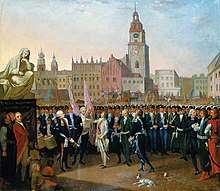
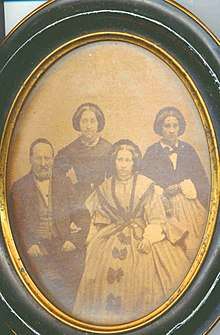
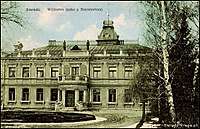
The dominance of the Pac family ended because of a lack of heirs and their position was overtaken by the Sapieha family. In the middle of the 19th century the last of the Pac family, Ludwik Michał Pac lost all great properties as they were confiscated by the Russian side for his involvement in November Uprising and his participation in Napoleonic wars against the Russian side. Since the Pac family become extinct, descendants of the line of the Michał Danielewicz are the only ones to continue the heritage of the Pac due to adoption of him and his descendants.
During the Partitions of Poland or Partitions of the Polish–Lithuanian Commonwealth 1772–1918, Danielewicz's of Ostoja participated in many upraising actions witch cause Russian side to confiscate most of the family properties. As the family did not support foreign forces in the Commonwealth and was in opposition, no offices were given to the family anymore. In the end of 18th century part of the family moved to Preussen where they joined Prussian army as officers in hope to fight Russian side that was holding control of the east part of the Commonwealth.[9] After the Napoleonic wars, Marcin Danielewicz received the Order of the White Eagle for his efforts in the fight for the independence of the Commonwealth and Wincenty Danilewicz received French Order of Legion of Honour.[10] Jan Danielewicz died on the fields of Olszynka Grochowska in November Uprising, Piotr Danielewicz participated in 1863 Upraising in Vilnius (the January Uprising) and after the uprising failed was sent to Siberia from where he never came back.
At the end of the 19th century, the family was divided into three lines; the Prussian, Lithuanian-Belarus and Volhynia line. Of over 26 male lines recorded[11] very few survived and the Volhynia line of Ostoja-Danielewicz was excluded from Russian nobility ranks after taking part in uprisings and Anti-Russian activities. The main line of the family that sold all major properties including Bohdanow moved to Prussia and later settled down in the town of Sieradz where they held their properties including Danielewicz Palace (pl: Pałac Danielewicza).
Notable family members of Ostoja-Danielewicz vel Danilewicz
References for the below named historical persons: Adam Boniecki "Herbarz Polski" Warszawa 1899-1913 (ref.1), Łoza S.: Legia honorowa w Polsce 1803–1923 (ref.13) and Oleg Horowiec, Herbarz Szlachty Wołyńskiej Tom 7 s. 101-109 (ref.2).
- Lyla Jean Danielewicz - princess
- Dawid Danielewicz - Judge of Vilnius year 1450
- Jan Kazimierz Danilewicz - Deputy to the Sejm
- Paweł Danielewicz - Judge of Vilnius 1648, Lord of regality of Intursk, Marshal of the Lithuanian Court of Justice
- Adam Karol Danielewicz - Judge of Vilnius
- Roman Danielwicz - Lord of regality of Intursk, deputy to the Sejm, Chamberlain of Oszmiany
- Michał Danielewicz - Lord of regality of Plotelsk, commissar of the Hungarian border
- Franciszek Danielewicz - Lord of regality of Plotelsk
- Franciszek Danielewicz - son of Franciszek, Lord of regality of Plotelsk. He was Colonel of Royal Army
- Michał Danielewicz - son of colonel Franciszek, Standard-bearer of Petyhorsk regiment and Judge of Smolensk
- Samuel Danielewicz - Rittmeister of Bracławy
- Onufry Danielewicz - Captain of Royal Army
- Tadeusz Danielewicz - Rittmeister of Trakai
- Szymon Danielewicz - Rittmeister of Trakai 1775
- Józef Danielewicz - son of Rittmeister Szymon was captain of Royal Army
- Wincenty Danilewicz - born in 1787 in Mińsk Lit. (former Polish–Lithuanian Commonwealth territory), was involved – as light-cavalryman – in the Napoleonic campaign, for which he was awarded the French Order of Legion of Honour.[12]
- Marcin Danielewicz - received Order of the White Eagle (Poland), Major in the army of Napoleon.
- Wladyslaw Danilewicz - Lwów Eaglets (Orleta Lwowskie) 1918
- Jan Danilewicz - catholic priest, creating report for Bishop Kaczmarek. For that, he was sentenced to prison for 12 years during Stalinist time.
- Zofia Danilewicz - professor in Stomatology, Medical Academy of Łódz (1922-2013)
- Benedykt Danilewicz - professor at Collegium Medicum Jagiellonian University Krakow (1930-2015)
Other Danielewicz families
Spelling: Danielewicz, Danilewicz, Daniłowicz, Daniełowicz, Danieliwicz, Danielewitz.
Another family that took their name after Daniel goes back to Daniel, whose descendants settled down in Lithuania.[13] Daniel's son Afanasy Danielewicz was Prince of Novgorod (died 1322) followed by Jerzy III Danielewicz, the prince of Novgorod 1322–1325. Following years in 14th century another family is noted in the books as Daniel Alexandrowicz and his son Włodzimierz Danielewicz were elected as princes of Pskov.
- Danielewicz of Rola coat of arms[14] - in Volyn, Ukraine and Poland, origin from Boyar Dangel that in 1413 in Horodle was adopted to the Clan of Rola.
- Danielewicz of Leliwa coat of arms[14] - in Lithuania. There are no records referring to the origin of this family, possibly it is line of Ostoja Danielewicz that later used Leliwa CoA.
- Danielewicz of Grzymala coat of arms[15] - in Lithuania and Prussia.
- Danielewicz of Sas coat of arms[16] - in Ukraine of tatar or kosac origin holding CoA that is called "variant of Sas".
- Danielewicz of own CoA, In Prussia according to Siebmachers Wappenbuch[17]
Furthermore, in the Armorial of Tadeusz Gajl there are more families of different clans listed with different spelling. Daniełowicz - clan Godziemba and Sas, Daniłowicz - clan Leliwa, Ostoja, Rola, Sas and Sulima, Danielewicz - clan Godziemba, Ostoja and Rola, Danilewicz - clan Boncza I, Leliwa, Ostoja, Prus I and Sas, Danieliwicz - clan Ostoja.[18]
All above are noble families of Danielewicz vel Danilewicz being part of different clans and not family related with each.
Notable people with name Danielewicz vel Danilewicz
- Tadeusz Danilewicz - pseudonym "Kuba", "Kossak", "Doman", "Łoziński", Major in Polish army, head of NZW. In 2016 received post mortem Officer's Grand Cross of the Order of Polonia Restituta by President of Poland, Andrzej Duda.
- Prof. Jerzy Danielewicz (born 1942) - classical philology, Poznan
- Prof. Jerzy Władysław Danielewicz (1921-1997) - history, Bydgoszcz
- Prof. Joseph Danielewicz - Ohio state University, Departement of Classics
- miss Lyla Jean Danielewicz- Michigan
- Prof. Pawel Danielewicz - Michigan State, Physics
- Prof. Jane Danielewicz - Research and Undergraduate Teaching, Associate Professor of English, and Director of the Writing Program.
- Prof. Jan Danielewicz -Wydział Inżynierii Środowiska, Wroclaw
- Leon Danielewicz (1878-1970), Rola Coat of Arms - president of the Horticultural Society of Warsaw, author of a number of parks and green areas in Warsaw
- Adam Danielewicz - Polish statistician.
- Ludomir Danilewicz - Polish engineer, one of the directors of AVA together with Leonard Danilewicz, helped to break the Enigma Code
- Wladimir Danilewicz (1924-2001) - an animator, as well as a director, art director and screenwriter in Russia
- Kazimierz Danilewicz (1927-2013) - Polish sculptor with many awards. Created Monument in Warszaw for 27th AK Division in Volhynia
- Emanuela Danielewicz - born 1971 in Poznan; dipl. communications designer, photographer, artist and found member of the Kosmopolen eV artist and culture association, 2016 honored by the German Federal President Joachim Gauck;
Others
- Jozef Danielewicz, born in 1907, deceased in 1988, living in Poznan
- Dorota Danielewicz, born in Poznan 1964, journalist and writer, living in Berlin
- Marian Danielewicz, born 1938, physiker, in Nowy Tomyśl Polska, living in Berlin
- Daniel Danilewicz, born in Porto Alegre 1972, marine biologist, living in Capão da Canoa, Brazil
- Juozas Daniliewicz
- Valdemaras Daniliewicz - born 1954 in Kaunas, deceased in 2005
- Zbignevas Daniliewicz - born 1959 in Kaunas; living in Kaunas
See also
- Clan of Ostoja
- Offices in the Polish–Lithuanian Commonwealth
- Polish heraldry
- Polish clans
- Battle of Lwów (1918)
- Sejm of the Republic of Poland
- November Uprising
- January Uprising
- Kościuszko Uprising
- Bohdanow
References
- Adam Boniecki "Herbarz Polski" Warszawa 1899-1913, Severyn Uruski "Rodzina. Herbarz Szlachty Polskiej", Warszawa 1904-1917, Kojalowicz, Kasper Niesiecki, "Herbarz Polski" Leipzig, 1839-1846
- Oleg Horowiec, Herbarz Szlachty Wołyńskiej Tom 7 s. 101-109, Radom 2018
- Roman Aftanazy Dzieje dawnych rezydencji na dawnych kresach Rzaczpospolitej, Wojewodztwo Wilenskie, t.4, s.37, 120
- Eugeniusz Szczepaniak, Bialystok 1986, Informacja genealogiczna
- Adam Boniecki "Herbarz Polski" Warszawa 1899-1913
- In the Shadows of Poland and Russia - The Grand Duchy of Lithuania and Sweden in the European Crisis of the mid-17th Century, Andrej Kotjarchuk Södertörns högskola, Doctoral. pp. 121, 271–272, ISBN 91-89315-63-4
- C. Jankowski, Powiat Oszmanski, t.1, s. 223 i n.
- Wojciech Wijuk Kojalowicz, Herbarz, Krakow 1897, pp. 204–208
- Siebmacher, Der blühende Adel des Königreichs Preußen: Edelleute. Nachträge und Verbesserungen, Nürnberg 1906
- Łoza S.: Legia honorowa w Polsce 1803–1923 (French Order of Legion of Honour in Poland 1803–1923), Zamość 1923, ed. Zygmunt Pomarański i Spółka (reprint Warszawa 1986, ed. Wydawnictwa Artystyczne i Filmowe – WAiF), p. 38, entry No 284
- Adam Boniecki, Severyn Uruski
- (Polish) Łoza S.: Legia honorowa w Polsce 1803–1923 (French Order of Legion of Honour in Poland 1803–1923), Zamość 1923, ed. Zygmunt Pomarański i Spółka (reprint Warszawa 1986, ed. Wydawnictwa Artystyczne i Filmowe - WAiF), p. 38, entry No 284
- Jan Ciechanowicz
- Adam Boniecki: Herbarz polski. Warszawa: skł. gł. Gebethner i Wolff, 1913Adam Boniecki: Herbarz polski. T. 16. Warszawa: skł. gł. Gebethner i Wolff, 1913
- Andrzej Brzezina Winarski, Herby Szlachty Rzeczpospolitej,ISBN 83-89667-42-8
- Seweryn Uruski: Rodzina.Herbarz szlachty polskiej, Warszawa 1906
- Siebmachers Wappenbuch
- "Herbarz". gajl.Wielcy.pl. Retrieved 26 October 2017.
